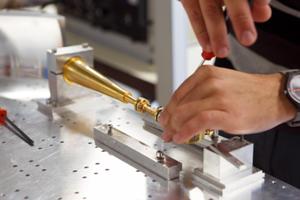Sep 25 2014
The Journal of Optics has devoted the front page of its special edition on Mid-infrared and THz Photonics to the work produced by the NUP/UPNA-Public University of Navarre researchers Víctor Pacheco-Peña, Víctor Torres, Miguel Beruete and Miguel Navarro-Cía (former student currently working at Imperial College London), together with Nader Engheta (University of Pennsylvania), one of the world's leading experts in metamaterials. In their research they have proposed various devices capable of redirecting electromagnetic waves with efficiency levels close to 100%.
 This image shows a researcher, Mario Sorolla, working in the Teralab at the Public University of Navarra. Credit: UPNA
This image shows a researcher, Mario Sorolla, working in the Teralab at the Public University of Navarra. Credit: UPNA
To explain what their work consists of they have put forward the following example: "If we shine a torch on a wall in which we have made a hole, experience tells us that the bigger the hole is, the greater the amount of light that will pass through to the other side. However, if we fill the hole with an ENZ metamaterial, something that appears to defy logic happens: the smaller the hole is, the greater the amount of light that passes through. This phenomenon has a tremendous practical implication because it opens up new ways of miniaturising numerous components and for light control."
Metamaterials are artificial materials with properties that go beyond those of natural means. To understand how they work, we can take a look at nature itself: while natural elements acquire their physical properties from the atoms that form them and the way in which they are ordered, metamaterials use natural means, like small metal fragments that fit together like parts of a Meccano model to artificially synthesise properties that are impossible to find otherwise. Initially put forward to control electromagnetic radiation, right now their use has become widespread and has extended to other areas like mechanical waves (sound, for example).
The piece of work referred to above proposes various compact devices comprising rectangular metal tubes with extremely narrow openings of dimensions designed in such a way that they are capable of redirecting the electromagnetic waves with levels of efficiency close to 100%. These gaps are capable of imitating an ENZ (Epsilon Near Zero, which means permittivity close to zero) metamaterial so that it is not necessary to "fill them" with anything in order to obtain amazing results.
Amazing Properties
Among the electromagnetic metamaterials, the above-mentioned ENZ ones make it possible to achieve the super coupling of the light, the tunnel effect and the confining of energy in tiny spaces. "Going back to the first example," say the authors, "super coupling means that all the light will be transferred from one side of the wall to the other through any shape of hole we want to make; tunnel effect refers to light passing through a hole of any length, no matter how long we want to make it; and the confining of energy is due to the fact that the light is transferred even through very small holes, so the energy inside the hole is squeezed enormously."
This work has shown theoretically and by means of simulations how beam steerers and power splitters work for terahertz waves, and is of tremendous importance in view of their huge potential in sectors like security, biomedical engineering, pharmacy, space, etc. Right now, the authors of this piece of research are working to confirm the study through experimental means. In this respect, they stress that "this constitutes another milestone in an initiative of an international nature that has been going on for nearly four years".
This news release is available in Spanish.
Source: http://www.basqueresearch.com/